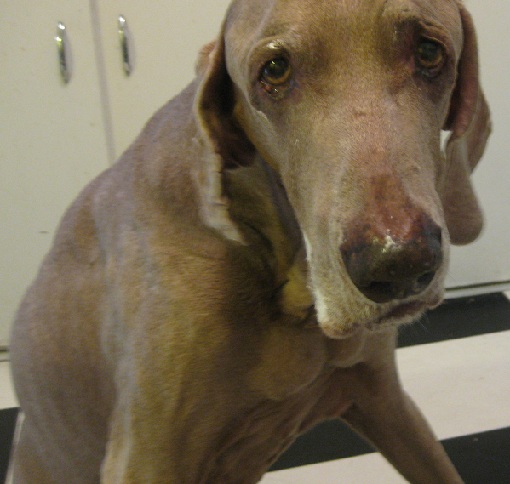
In eight profound months, beginning in October of 2010, my perceptions of time, communication, dignity, and the power of intention were forever altered by the paradoxical process of helping my ninety-pound, 16 year old Weimaraner companion named Yeager live well as a very old dog, for as long as nature allowed. As it was, he spent 25 percent of his life outliving his life expectancy. On June third of this year, in his favorite blue chair, confiscated as his own the first day he entered the house, Yeager died in my arms without pain, suddenly but naturally. Grief, shock, loneliness came.
Guilt and regret for what I might have or not have done, however, did not.
It was the final moment of mutual attentiveness begun the day I'd adopted him from Friends for Pets a decade earlier. He was six then. Unlike Yeager, dozens of dogs will live out the rest of their lives in the no-kill Friends for Pets shelter, passed over for adoption simply because they're disabled or perfectly healthy but older in years. To provide for their care, we've created a fundraising effort in his memory, called The Yeager Fund (http://www.friendsforpets.org/monetarydonations.php#yeager
Still, many adopted dogs who are equally beloved die less ideally and leave behind conflicted humans. Certainly the luck of Yeager's genetics take big credit for his healthy longevity. As much as anyone can direct the mechanics of fate, however, his peculiar longevity, given his size and breed, was also the result of new skills honed to first anticipate, and then accept the challenges of his last months. It meant investing physical, emotional and financial resources, learning to acutely prioritize, seek the wisest counsel and, most elusively, develop an intuitive instinct about Yeager's evolving state of mind and body.
Since then, I've encountered strangers, neighbors and other familiar faces who long cheered Yeager on in that eight month period, themselves now confused and anxious at the first signs of age debilities in their dogs. Many are reacting to the diagnoses and suggestions of vets, but to passively accept the edict of one professional without a wider search for answers and consultation of the wisest "opinion" - that of the dog, is sometimes enough to kill an old dog prematurely.
If people can commit to certain preparations and modifications, they can ensure the best chance of their healthy old dog aging without pain into a very old one.
Thousands of books and articles help us help puppies mature into their prime but anything about caretaking very old dogs is inevitably devoid of both the practical realities and the emotional rewards of that process. In those which do touch on the subject, a lot of gentle euphemisms are employed in place of an honest consideration of euthanasia, non-medical tactics to cope with non-life threatening issues, the potential for shifting our perceptions of human life - let alone mention of the best wee-wee pads.
In reviewing Yeager's last eight months, however, I now recognize turning points and crossroads where decisive action proved crucial to us both and which may perhaps help others experiencing what can be as enlightening and joyous a period as it is brief and poignant.
I've discovered many, but here are a few, embedded in an abbreviated version of that time, from October 2010 to June 2011.
~~~~~~~~~~~~~~~~~~~~~~~~~~~~~~
1. Determine if there's Pain
First and foremost, determine if your old dog is in pain - whether it's permanent, worsening, temporary or relievable. Everything else you do will stem from resolving this issue. It's not always easy. Some dogs that feel pain won't reveal it obviously by how they act, striving to get on with life as usual, but the slightest difference in behavior can clue you in. Are they still excitedly running into the kitchen to eat but slower in getting there? Do they react sharply if you touch them in some places? It might be the first signal of a debility that will become entrenched - or it may be nothing. And keep checking, constantly.
Along these lines, I learned not to assume a dog's changing physicality always means pain.
Last October, Yeager paused to sniff some hedges during a morning walk. He was also shuffling, a bit slower than usual. He didn't as much as fall as he sat back on his hind legs. It was the third day in a row of cold and rainy weather, so I assumed he'd slipped. When we got home, I finished packing for a rare trip of six days. Rather than pull himself and climb onto my bed, however, he paused in an odd sloped position, lowering his back and bending his knees but not sitting.
I immediately assumed he was suddenly, finally showing signs of the dreaded hip dysplasia, common to older, larger dogs. For months, some worry-wart woman insisted it just had to be that when she saw him sloping outside of Peet's Coffee on Larchmont Boulevard in Los Angeles http://www.peets.com/ There, he routinely waited outside while I dashed in for coffee. Luckily, the dog-friendly atmosphere there meant lots of other pooches engaged him for the few minutes we were separated and more often than not kept him circling around as far as his tied leash permitted, rather than keep him standing stationary. In fact, Yeager wasn't suffering hip or knee pain but rather the lack of feeling in his toes and legs.
During his first examination by a veterinarian who treated him to nearly the end, a potential issue was detected that proved to be so subtle that when I brought Yeager in upon my return from my October trip, even the vet had nearly forgotten about his lower-back, pinched-nerve which was now worsening and leaving his feet numb.
In this situation, making a daily assessment helped me take other measures immediately to help him carry on as he wished. Medical conditions might plateau for a long time in an old dog. They are sure to deteriorate in a very old dog.
Towards the end of his life, a more alarming health issue arose suddenly.
Despite his eagerness to still walk and eat, I assumed he was in pain. I called in a Los Angeles vet to perform a home euthanasia. Dr. Steven Smith arrived with his medicine bag to examine Yeager. http://www.homepetdoctor.com Without regard to any potential profit, Smith declared, "He's in slight discomfort but no pain." He didn't recommend euthanasia. For Yeager, that was the right decision.
2. Home Adjustments
If it was still easy to forget that Yeager was an old dog when I left for a six-day trip last October, when I got back, it was obvious that I'd returned to a very old dog. It required immediate and gradual home adjustments.
Before I had left, I feared that he'd really take a bad fall if he tried to keep getting up on my bed to nap when I was gone. He was being looked in on every three hours, but the old boy was still a hellion when nobody was looking. Twenty minutes before I left for the airport, I impulsively dissembled my bed and temporarily put the mattress on the floor.
It proved not to be temporary.
Yeager still persisted in climbing onto the sofa and his blue chaise lounge . More often, however, when roused by someone outside, he now looked tentatively at the slippery wood floor first and sometimes decided to do his hoarse barking from the safety of the chair. He still bounded into the kitchen, anticipating dinner though now if he waited in a stationary mode more than a few minutes, his feet were starting to slide and made him constantly reposition his stand. In fact, the condition of his numbed toe nerves was worsening and he was losing the ability to grip the floor. Lining his pathways at home with rugs made all the difference.
Sturdy twine rugs looked great but proved futile. In the end, rugs with rubber backing did the trick. That Target had sold out of long and plush versions and only had shorter, washable rugs proved fortuitous. (http://www.target.com/c/home-home-décor-rugs/-/N-5xttg#?lnk=nav_t_spc_5_inc_4_10).
As time went on, it took Yeager longer to get outside to relieve himself and it was vastly more efficient to wash a few short rugs he'd dribbled or streamed on. It also meant moving furniture to clear a beeline for the door. Soon enough, there was a ramp down the two front steps and back ones.
The water bill's sudden spike wasn't due to rug-washing alone. By Halloween, there was dribbling while he slept. And that called for my own unique system of three layers of different materials, two washable and one disposable, to match his size and sleeping habits and keep both him and the bed dry. Trying all sizes and brands, the simple "Training Pads" I found in a Safeway, part of its Priority Total PetCare line, proved the most reliable and radically inexpensive by comparison to products in pet stores. http://www.safeway.com/IFL/Grocery/Our-Brands For total insurance, another trip to Target found me investing in water-repellant bed coverings. Diapers were a temporary but failed effort. He liked shaking or tearing them off.
3. Old Dog Support
The greater resistance to change, however, came with old dog support products that Yeager found himself attached, contained by and snapped into. It was time to force him into a pair of booties I'd bought back after Yeager was misdiagnosed at 13 years old with the nerve disorder Degenerative Myleopathy.
Like a bad kid protesting footsie pajamas, Yeager never stopped stiffening his feet when I tried to get them on him, surely not caring that the large round black cloppers made him look like a canine Mickey Mouse, just that they felt odd.
Once on him, however, the booties soon gave out, this brand being not only too thin but lacking a firm hold around the ankles, turning, tearing and falling off. The sturdiest and most secure ended up being the red Rugged Boots among the many choices offered by Ultra Paws. http://www.ultrapaws.com/Ultra-Paws-Rugged-Dog-Boots/productinfo/303R/
The search for the ultimate dog bootie led me into the extraordinary universe of disabled and senior animal products of endlessly promising diversity (harness lifts, memory-foam beds, ankle supports, back braces, to name but a few).
At great cost, I learned the hard way that many products seem ideal online, but vary greatly in terms of quality and cost, catering more to small dogs that can be hand-carried around rather than the big all-elbows Marmaduke-types like Yeager.
In his last weeks, certainly nothing better than the Help 'Em Up Harness by Blue Dog Designs (with handles like luggage) helped him rise and be lifted into the car. http://helpemup.com/store/#&panel1-2
You can see some of the items that worked for him towards the end of this tribute: http://carlanthonyonline.com/tribute-to-yeager-the-weimaraner/
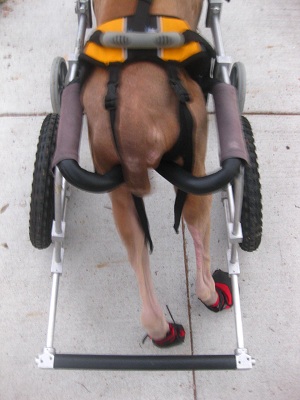
Geared up in his Help 'Em Up Harness, Eddie's Wheels cart and Ultra Paws Rugged Dog Boots
4. Wheels
Nothing proved as vital to lifting his sloping back, reducing his leg and foot numbness and letting him continue his walks as did "the cart," a dog equivalent of the walker and wheelchair for people and what, eventually, the old boy took as if it were King Fido's royal carriage.
For a solid month I plunged into an ocean of websites, help boards and Jerry-rigged contraption blueprints claiming to help dogs that were full or partially paralyzed, missing a limb or just ancient.
I ultimately narrowed it down to which one promised to best support Yeager's unusually long back. It ended up being the most expensive. It also ended up saving his life.
After meticulous measurements of every possible body part's length, I put the order in for his custom-made cart from Eddie's Wheels. http://www.eddieswheels.com
Once it arrived, I slipped his back legs into the strongly-constructed cart, and secured the chest strap. Yeager stared blankly at me, seemingly offended. He wouldn't budge. Eventually, he realized he wasn't going anywhere unless he tried to walk in the cart. Once he did, he took off. It was a poignant moment.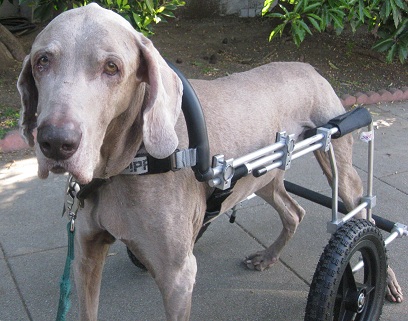
I did buy the cart sooner than he really needed it, and for many months, I simply pulled it along in case Yeager suddenly sloped or tired.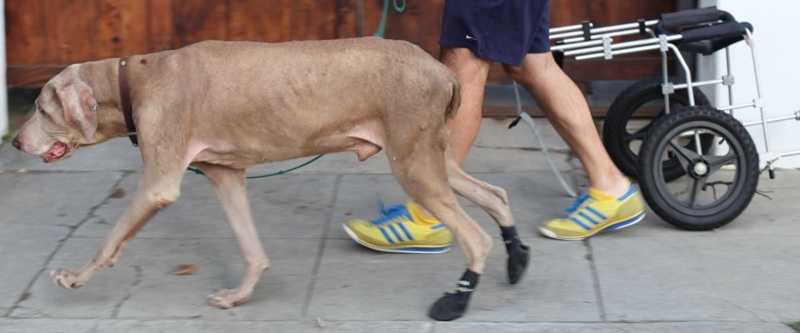
Not for months would I realize just how perfectly it fit, not until he could no longer make his full round without it, by mid-February 2011.
A month later, detecting a weakness in his left wrist and shoulder, I added on front wheels from Eddie's Wheels. It was ironic that, while aging was causing some muscle loss, having to continue using all four legs was also building muscle gain.
It was not that last illness nor his pinched-nerve, however, which caused Yeager's lethargy that October morning. Likely due to the suddenly cold weather, the old boy had contracted pneumonia and nearly died during the six days of our separation. But he didn't. Yeager's regular vet put him on medication and he recovered. Six months later, after an April checkup, however, I faced a fact about the vet himself which I'd been reluctant to believe. And it had nothing to do with Yeager's health - directly.
5. Vet the Vet
By November, I'd begun recording any slight change in Yeager's condition and questions about his medicines' side affects, and taking these to the vet. Hell, yes, it was obsessive, but three times in the past I'd immediately detected mast cell tumors on Yeager this way, and each time it saved his life. Reacting to the vet's sudden passivity towards my questions, I apologetically added I wasn't questioning his professionalism, nor seeking to make Yeager live beyond nature's turn but only to prevent what could be prevented, especially potential pain.
On this April visit, I'd come with two friends, familiar with Yeager's condition, but the vet told his assistant to prevent them from joining us. Days earlier, I felt a small but solid lump in Yeager's abdomen and asked the vet what it was. "Could be anything," he murmured, avoiding my gaze. "Is there a test to tell what it is?" He mumbled nothing in particular. I asked if it was cancer. All I got was, "Could be anything."
In that moment, I realized he'd abandoned any camaraderie we'd shared on Yeager's behalf, and any respect I'd accorded him as an authority figure abandoned me. I also saw my culpability in ignoring my own instincts about this vet, especially after Yeager had been kept waiting on a floor for three hours for a scheduled x-ray that was continuously ignored. He'd been great treating Yeager in his prime, though always highly uncommunicative, but once it seemed the old boy's months were numbered, Dr. Could-Be-Anything failed.
That's why it's vital to vet the vet, by which I mean scrutinize whether even the most reliable of veterinarians is both professionally and emotionally equipped to care for your old dog to the end.
Before I'd been able to carefully chose a new vet for Yeager, however, an emergency arose on the morning of May 9.
Yeager's abdomen was suddenly swollen with what proved to be bodily fluid produced in reaction to a pancreas dysfunction. I had to make an immediate decision and so I rushed him to a vet recommended by a neighbor. The vet was sweet but obviously distracted with personal matters. After pumping his stomach to relieve his discomfort, she simply vanished from the office, leaving no report or instructions for his care - just the bill. Ticked off by my insistence she be contacted at home, she blithely relayed a message to feed him normally. I did what she said. It proved nearly fatal.
Enjoying a stroke of luck when rushed him the next day to Animal Surgical and Emergency Center, he was treated by Dr. McGee Leonard. The facility astounded me in terms of its professionalism and state-of-the-art capabilities. http://www.asecvets.com
Dr. Leonard articulated care instructions and her combination of medical specificity and personal compassion relieved me. Her tests could not conclusively prove whether Yeager had pancreatic cancer or severe pancreatis.
While it wasn't possible to have him regularly treated by an emergency vet, a glowing report about the especial care for senior dogs possessed by the Veterinary Care Center's Dr. Khara Johnson led us to her. http://www.veterinarycarecenter.com/
By two more strokes of good fortune, Dr. Johnson had opened her practice a week before, just three blocks away. Her patient care and comfort of Yeager surpassed any regular vet he'd seen. Despite the pressure of opening a new practice, she always took my calls, said she didn't know - if she didn't know, and spent generous time speaking to me about what I realized was only a matter of weeks. After the turmoil of finding the right vet, she was a godsend in his final days.
6. Adjust the Diet
Throughout his very old years, Yeager's appetite remained intense and he gained weight easily. With a senior dog's weight being a serious factor in their longevity, it was a constant battle to keep him trim since letting him trot for long stretches could easily exhaust him.
After a new round of research on optimum weight for his size and age, but conscious of the importance of consistency to what a dog ate and how much Yeager loved his regular meals, I needed to carefully adjust the diet.
In 2008, after Yeager's misdiagnosis with D.M. and finding the national expert on it, Dr. Roger L. Clemmons of the University of Florida at Gainesville veterinary school (but long before it became obvious Yeager did not have D.M.) I began feeding the old boy the special diet which the veterinarian recommended, mixed with some dry kibble.
It consisted of ground meat (pork, turkey, chicken) carrots, molasses, olive oil, green peppers, spinach, brown rice, broccoli, bone meal, dry mustard, crushed garlic clove, dry grounded ginger - each ingredient is included to address specific symptoms. The full recipe is found here: http://neuro.vetmed.ufl.edu/neuro/DM_Web/DMofGS.htm
Since it was so healthy and certainly didn't hurt, I continued to feed it to Yeager.
When he showed symptoms that suggested the adrenal disorder Cushing's Disease, I researched that and learned how ethoxyquin, a common preservative in commercial dog food was hard on the canine immune system and could worsen conditions like Cushing's.
Repeated testing never showed he didn't have it, but in the interim I'd searched and found Flint River Ranch's "SeniorPlus" natural dry food for seniors, consisting of meat proteins, fruits, herbs, grains, vitamins and minerals. Although freshly-made, it also proved less expensive than commercial dog food. http://www.frrco.com
Unlike numerous (and expensive) medicinal tonics and powders he tried, the Clemmons-Flint River diet noticeably strengthened Yeager's condition even in his last months though the amount was regulated to maintain optimum weight.
~~~~~~~~~~~~~~~~~~~~~~~~~~~~~~~~~~~~~~~~~~~~~~~
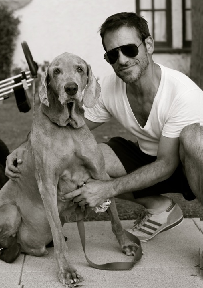
These are just a few among many other guidelines which helped Yeager not only live as long as he did but engaged and active, without pain. They all now seems sensible and obvious, but at the time it was a matter of trial and error, search and discovery.
Not until the last month did I really take stock, however, of how exhausting and depleted it often left me - and how that could affect my care of him. In that sense, Helping Yourself Help An Old Dog Live Longer and Well, may be the most important truth. To read that article in this series, go to http://carlanthonyonline.com/2011/11/14/helping-yourself-help-a-very-old-dog-live-longer-and-well-last-in-a-series/
To see other photographs illustrating this story, go to: http://carlanthonyonline.com/2011/11/11/helping-a-very-old-dog-live-longer-and-well-first-in-a-series/